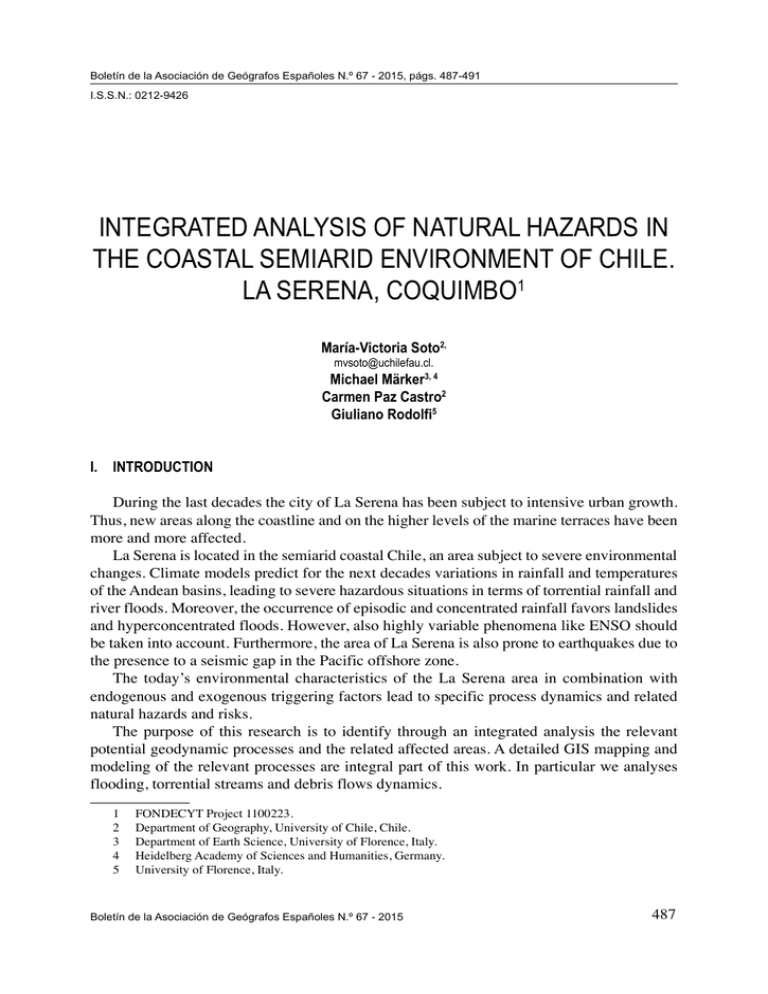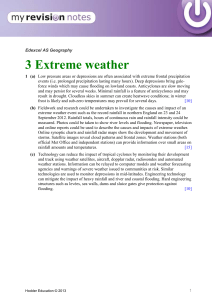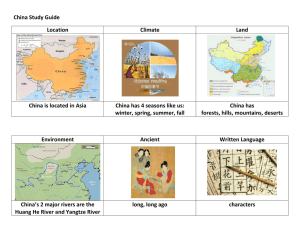integrated analysis of natural hazards in the coastal semiarid
advertisement

BoletínIntegrated de la Asociación analysis deofGeógrafos natural hazards Españoles in theN.º coastal 67 - 2015, semiarid págs. environment 487-491 of Chile. La Serena, Coquimbo I.S.S.N.: 0212-9426 INTEGRATED ANALYSIS OF NATURAL HAZARDS IN THE COASTAL SEMIARID ENVIRONMENT OF CHILE. LA SERENA, COQUIMBO1 María-Victoria Soto2, mvsoto@uchilefau.cl. Michael Märker3, 4 Carmen Paz Castro2 Giuliano Rodolfi5 I. INTRODUCTION During the last decades the city of La Serena has been subject to intensive urban growth. Thus, new areas along the coastline and on the higher levels of the marine terraces have been more and more affected. La Serena is located in the semiarid coastal Chile, an area subject to severe environmental changes. Climate models predict for the next decades variations in rainfall and temperatures of the Andean basins, leading to severe hazardous situations in terms of torrential rainfall and river floods. Moreover, the occurrence of episodic and concentrated rainfall favors landslides and hyperconcentrated floods. However, also highly variable phenomena like ENSO should be taken into account. Furthermore, the area of La Serena is also prone to earthquakes due to the presence to a seismic gap in the Pacific offshore zone. The today’s environmental characteristics of the La Serena area in combination with endogenous and exogenous triggering factors lead to specific process dynamics and related natural hazards and risks. The purpose of this research is to identify through an integrated analysis the relevant potential geodynamic processes and the related affected areas. A detailed GIS mapping and modeling of the relevant processes are integral part of this work. In particular we analyses flooding, torrential streams and debris flows dynamics. 1 2 3 4 5 FONDECYT Project 1100223. Department of Geography, University of Chile, Chile. Department of Earth Science, University of Florence, Italy. Heidelberg Academy of Sciences and Humanities, Germany. University of Florence, Italy. Boletín de la Asociación de Geógrafos Españoles N.º 67 - 2015 487 María-Victoria Soto, Michael Märker, Carmen Paz Castro & Giuliano Rodolfi We conducted a detailed geomorphological analysis to identify, validate and calibrate indicators of endogenous dynamics associated with natural hazards. The analysis consists of field work, GIS applications and modelling. The hazard mapping was done on the basis of geomorphological, hydrologic, groups of soil information and GIS processing of topographic information, as described subsequently: Following topographic units were identified: i) slopes and correlative deposits, based on the conditions of the slopes and ii) alluvial fan and pediments as features that provide sediments to the local fluvial system. The Soils were considered important for the analysis of the hazardous conditions because the study area corresponds to inherited Quaternary marine terraces, where different paleo soil characteristics generate particular responses to rainfall. The identification of hydrological soil groups following Soil Conservation Service was applied as a first approximation of the hydric behavior on the soil. For the morphometric analysis we worked with a raster DEM (25 m resolution) based on ASTER satellite data. Since the ASTER GDEM is a landscape model containing still information on infrastructures and vegetation we eliminated these features (such as high-rise buildings and areas with vegetation and interpolated the terrain elevation. The model was hydrologically corrected and preprocessed for analysis using SAGA GIS. Processes related to water erosion were modeled through four topographic indices: Stream Power Index (SPI), Topographic Wetness Index (TWI), Transport Capacity Index (TCI) and Modified Catchment Area (MCA). The modeling works under the assumption that the landscape has homogeneous substrates. The indices were derived directly from the DEM. II.RESULTS II.1. Present day geodynamic processes Today’s geodynamic process are considered those related to concentrated rainfall events, that generate conditions of stress and loss of equilibrium of the semi-arid coastal morphological systems, such as the activation of streams, runoff on alluvial fans, erosion on the marine terraces scarps and flood processes. The geomorphology of the area reflects a quaternary, inherited landscape, which present activity under certain rainfall threshold. The marine terraces in La Serena have their very well-defined scarps with altimetry distinct levels that correlate with different ages of formation. The analysis of the geomorphological units reveals the dynamic processes as potential generators of natural hazards. In this context, the dissected streams have been considered as torrential streams, also due to the coarse material in the stream bed. The alluvial fans and the steep parts of the terraces have been identified as features susceptible to generate debris flows, due to high amount of detritic material available. 488 Boletín de la Asociación de Geógrafos Españoles N.º 67 - 2015 Integrated analysis of natural hazards in the coastal semiarid environment of Chile. La Serena, Coquimbo The largest territorial units are marine terraces, which have a very low slope, from 0-5.0° and that are not subject to mass removals, except where the torrential streams and alluvial fans are present. II.2. The integration of soil information For to integrate the hydrological soil groups, we considered the spatial distribution of C and D group of soils, because they are characterized by low infiltrabilities related to fine textures and leading to increased surface runoff and hence flooding. The results from the superposition of geomorphology and soil groups shows that the holocenic terrace levels, with very low slope, correspond to saltmarsh level, with beach ridges and marsh areas. They coincide with the C and D hydrological soil group. This confirms the conditions for flooding due to very low infiltration capacity. Thus, especially in the lower parts of the city a high susceptibility for surface runoff and flooding was identified. On the higher terraces there are no significant flood conditions associated with hydrological soil groups due the nature of these units: i ) sedimentary material consisting of sands and gravels, ii) texturally with good infiltration conditions. Even heavy rainfall events do not produce surface runoff. Thus the surfaces of the Pleistocene terraces can be considered as having no susceptibility to natural hazard related to exogenous processes. II.3. Terrain Analysis The morphometric indices derived through GIS processing have been used as relative indicators of natural hazard. The Stream Power Index (SPI) index for describing the effects of linear fluvial erosion processes, such as gullies, ravines and lateral erosion of beds. The study area, given the marine terraces landscape, represents a rather smooth relief, although these terraces have been uplifted tectonically. In this sense the SPI highlights the ravines and stream incisions, which in the case of La Serena shows hazard condition especially in the granitic slopes and the escarpment of the terraces. The Topographic Wetness Index (TWI), was applied assuming a uniform substrate in terms of lithology and depth. Hence, the topography is the dominant factor. The TWI provides information on the accumulation of water and soil saturation. Consequently, the index allows to derive information of dynamic processes, such as runoff and flooding. The application of this index to the Bay of Coquimbo, reveals the susceptible areas to accumulate water, especially spread on the lower terrace (marsh level), and within the streams and high terraces. The TWI highlights the existing topographical irregularities, so that the depressions in the units are potentially water storage areas. The Transport Capacity Index (TCI), shows the areas affected by sheet erosion, sediment transport and associated deposition processes. The results provided by this index illustrate how the slope systems around the city and the associated streams and ravines are important in terms of their hazardous potential or the new urban areas in especially the northern part of the city. Boletín de la Asociación de Geógrafos Españoles N.º 67 - 2015 489 María-Victoria Soto, Michael Märker, Carmen Paz Castro & Giuliano Rodolfi The modified watershed (MCA) is based on calculations that take into account the flow pattern. The MCA provides an approximated estimate of the potential flood areas in extreme rainfall events. In La Serena the urban streams and the lower terrace, belonging to soil hydrologic groups C and D, are belonging to the flooded areas. II.4. Identification of the natural hazard associated with exogenous agents Overlapping geomorphology, soil characteristics, and the information derived from the modeled topographic indices through GIS applications tools allowed to identify the spatial distribution and intensity of potential environmental hazards. The lower area of the La Serena area, which is associated to the marsh level represent the highest potential for the occurrence of flooding processes. Particulary the topographic and textural constraints for drainage and infiltration processes as well as the amount of water arriving to these areas make then highly susceptible to flooding. This terrace level extends across the bay. The other areas showing a very clear susceptibility to flooding hazard are the stream areas. In these areas floods, debris flows and erosion occur. The streams in urban areas are characterized by channels related to steep terraces (that indicate tectonic genesis). This stream beds starts on high terrace levels and alluvial fans, also identified as a source area of debris flows. These streams drain superficially into the city and flows to the lower level marsh areas. The hazard is associated with gullying and small debris flows in the escarpments of the channel, and river flooding in the lower part due to flow concentration and stream load during a heavy rainfall event. II.5. Triggering conditions. Although the geomorphology, soils and topography provide specific information on the processes that can be generated, the main driver is the concentrated or heavy rainfall that occurs in the Chilean semiarid region due El Niño and the Oscillation Pacific decadal. The annual rainfall in La Serena amounts to 75mm. However, during El Nino phenomena these values alter significantly. During one day or few hours rainfall can reached and exceeded the average annual rainfall. Such events allow understanding how the semiarid morphological system presents rainfall thresholds that can trigger subaerial processes that favour conditions for natural hazard. III.DISCUSSION The presented approach integrating information on geomorphology and hydrological soil groups is consistent with each other given the genetic relationship between both, but at the same time provides own background landscape study area. In this context, the low terrace, swamp level, characterized by C and D hydrologic soil group, are those of very poor drainage and consequently correspond to areas of flooding. Regarding the dynamics of streams are associated with debris flow processes. This consideration is based on the degree of incision of these torrents and the presence of coarse material in the bed. However these situations only can occur during heavy rainfall events. 490 Boletín de la Asociación de Geógrafos Españoles N.º 67 - 2015 Integrated analysis of natural hazards in the coastal semiarid environment of Chile. La Serena, Coquimbo The modeling performed with GIS tools highlighted those aspects of marine terraces and streams, constituting potential areas for mass transport and surface runoff. Through these modeling the flood hazard areas between the coastline and the escarpment of the terrace were identified. The stepped terraces are related to favorable conditions for runoff. IV.CONCLUSIONS This study presents an integrative approach to assess the susceptibility to natural hazards in the Bay of Coquimbo, with the city of La Serena. The combination of geomorphologic, soil and topographic characteristics reveal information about the generation of natural hazards especially associated with surface runoff and concentrated flows leading to flooding and debris flows. Flooding is likely to occur in the lower terraces which are associated to the coastline. The lower terrace is subject to flooding due to poor soil drainage. The other terrace surfaces are not subject to this hazard because of their good drainage conditions. The debrisflow can be generated within the streams, which were identified as torrential. This situation is also implying a vulnerable condition due to the urban expansion of the city. The main triggering factors for these types of hazards are concentrated and heavy rainfall events. Boletín de la Asociación de Geógrafos Españoles N.º 67 - 2015 491




